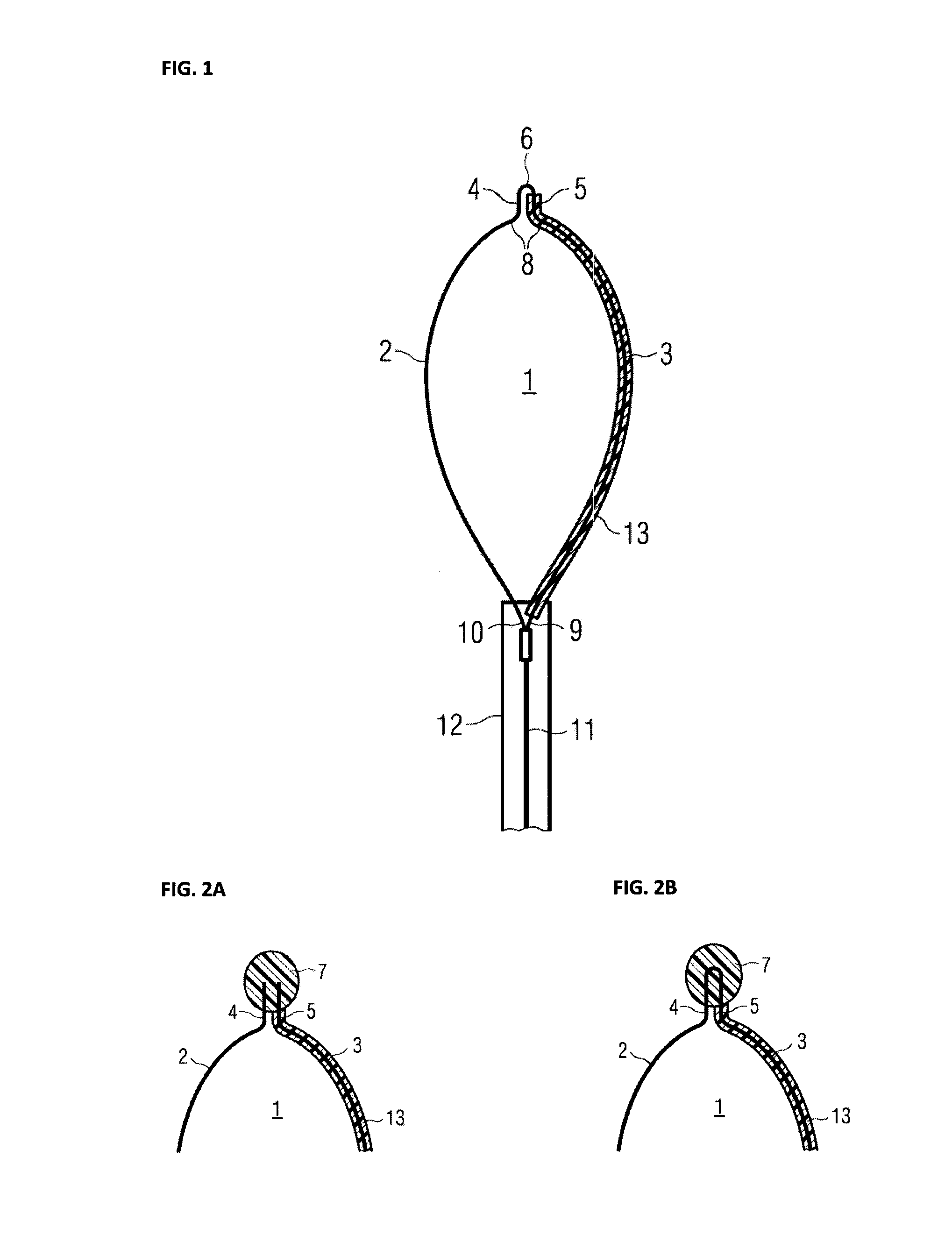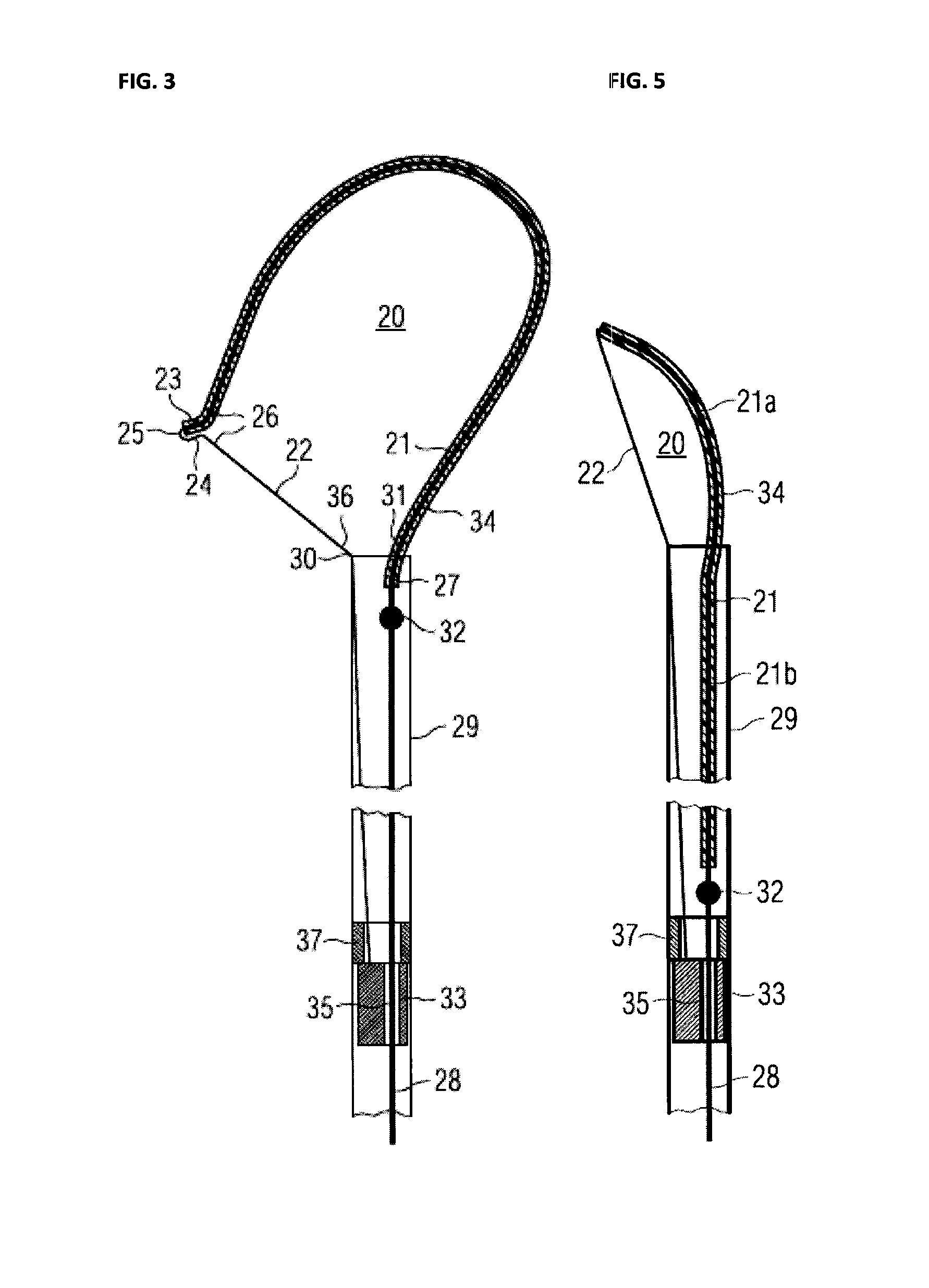If a malignant tumor has grown into the blood or
lymph vessels, malignant
tumor cells may find their way through these vessels into other, and particularly vital, organs and there form metastases which cannot be easily treated or be treated at all.
If a
pathological mucosal-submucosal area projects too little or not at all above the normal mucosal-submucosal area, it cannot be securely ensnared or ensnared at all with a polypectomy snare and cannot be ectomised.
However, as the size of the polyps ectomised or mucosal-submucosal areas resected in toto and en bloc has increased, the resulting problems and complications set out below have increased with the use of the snares available hitherto for EPE and EMR and the RF generators available for operating these snares.
One of these problems consists in the fact that particularly with en-bloc separation of large polyps or large-area mucosal-submucosal areas, particularly if through submucosal injection these become even greater than they are already before injection, is the electrical power required for this.
If this tissue is heated
too slowly or with too long a
time lag, which it is feared may result in a
delay in initial incision, the heat created here may diffuse from the tissue into the adjacent tissue close to the snare and damage the adjacent tissue thermally.
If for the abovementioned reason the snare is applied close to the
organ wall, the muscularis propria may be thermally damaged by it.
Thermal damage to the muscularis propria or even the serosa of a hollow organ of the gastrointestinal tract may result in perforation of this organ and will not infrequently make an open
surgical operation necessary.
Bipolar snares have, however, not proved satisfactory in clinical applications.
For this reason bipolar snares have not proved satisfactory in practice.
Although snares of this kind require less RF current during the initial-incision phase and during the incision phase than snares of the same size without insulation, they have the
disadvantage that the RF-surgically effective part of the snare viewed from an
endoscope is always behind the polyp, that is, is out of
sight, and there is a risk that the distal tip of the snare can perforate the
organ wall unmonitored.
This form of
electrode may, however, hinder accurate incision.
Both with electrosurgical instruments in accordance with U.S. Pat. No. 5,078,716 and DE 100 28 413 A1 and coagulating instruments in accordance with DE 25 14 501 the RF-surgically effective
electrode surfaces can be disposed only at the distal end of the snare, with the
disadvantage that these, seen through an
endoscope, are always behind the tissue to be removed and the incision therefore has to be made without
visual monitoring, which is a risky process, particularly with large polyps or mucosal-submucosal areas.
A further problem is the placing of the snare around in particular large or oddly shaped polyps or around polyps or mucosal-submucosal areas which have become enlarged through the injection of physiological NaCl solution or other injectables into the
submucosa, that is, by submucosal injection, enlarged or oddly shaped polyps or mucosal-submucosal areas.
A further problem is the placing and guidance of the snare as close to the organ wall as possible in order to separate the tumor close to the muscularis propria for the above-mentioned reasons.
With multi-strand or braided standard snares this is normally not practicable, because these snares are too soft or too flexible for this.
The use of these snares is, however, hazardous in so far as because of the pressure against the organ wall they can also
cut into or even through the organ wall.
A further problem, particularly with large polyps or mucosal-submucosal areas with an abnormally slippery surface may be that the snare slips out of the intended position while being applied or manipulated.
Since wide open snares, especially when being placed around flat polyps or mucosal-submucosal areas, cannot or must not be pressed against the organ wall concerned sufficiently firmly, they may, when the snare is closed, slip over the slippery
mucous membrane and out of the intended position.
On asymmetrical snares claws, hooks or teeth of this kind interfere with the function of the above-described driving device.
Although endoscopic polypectomy and endoscopic mucosaresection are regarded today as clinically established methods, these methods are presumably also because of the above-described problems attended with various complications.
Both because of the above-described problems and because of the
complication rate rising due to the
mean diameter of the tumor the hitherto available abovementioned methods and snares only can only be used to remove polyps or mucosal-submucosal areas in toto and en bloc with a maximum
mean diameter of up to approx.
With these methods larger polyps or mucosal-submucosal areas can be removed only by a piecemeal technique and often not radically or completely, a circumstance which may result in relapses.
These methods, however, call for a high degree of manual dexterity, experience, constant training, a willingness to take risks and long operating times. So far there have been only a very few experts who practise these methods.
 Login to View More
Login to View More  Login to View More
Login to View More 


